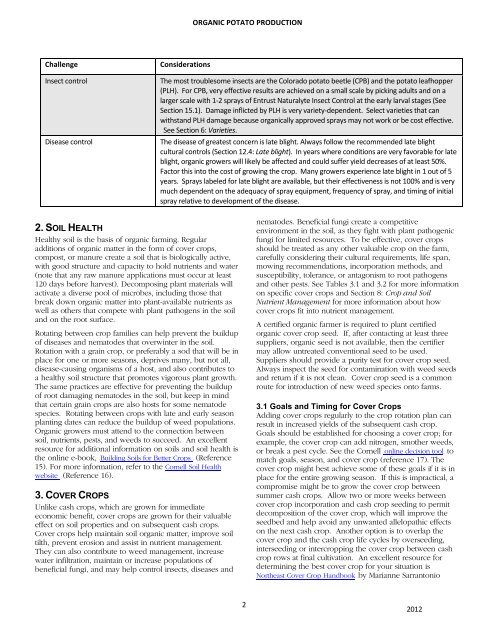potato 5-9-12 CLEAN - Vegetableipmasia.org
potato 5-9-12 CLEAN - Vegetableipmasia.org
potato 5-9-12 CLEAN - Vegetableipmasia.org
Create successful ePaper yourself
Turn your PDF publications into a flip-book with our unique Google optimized e-Paper software.
(Reference(ReferenceORGANIC POTATO PRODUCTION Challenge Insect control Disease control Considerations The most troublesome insects are the Colorado <strong>potato</strong> beetle (CPB) and the <strong>potato</strong> leafhopper (PLH). For CPB, very effective results are achieved on a small scale by picking adults and on a larger scale with 1-‐2 sprays of Entrust Naturalyte Insect Control at the early larval stages (See Section 15.1). Damage inflicted by PLH is very variety-‐dependent. Select varieties that can withstand PLH damage because <strong>org</strong>anically approved sprays may not work or be cost effective. See Section 6: Varieties. The disease of greatest concern is late blight. Always follow the recommended late blight cultural controls (Section <strong>12</strong>.4: Late blight). In years where conditions are very favorable for late blight, <strong>org</strong>anic growers will likely be affected and could suffer yield decreases of at least 50%. Factor this into the cost of growing the crop. Many growers experience late blight in 1 out of 5 years. Sprays labeled for late blight are available, but their effectiveness is not 100% and is very much dependent on the adequacy of spray equipment, frequency of spray, and timing of initial spray relative to development of the disease. 2. SOIL HEALTHHealthy soil is the basis of <strong>org</strong>anic farming. Regularadditions of <strong>org</strong>anic matter in the form of cover crops,compost, or manure create a soil that is biologically active,with good structure and capacity to hold nutrients and water(note that any raw manure applications must occur at least<strong>12</strong>0 days before harvest). Decomposing plant materials willactivate a diverse pool of microbes, including those thatbreak down <strong>org</strong>anic matter into plant-available nutrients aswell as others that compete with plant pathogens in the soiland on the root surface.Rotating between crop families can help prevent the buildupof diseases and nematodes that overwinter in the soil.Rotation with a grain crop, or preferably a sod that will be inplace for one or more seasons, deprives many, but not all,disease-causing <strong>org</strong>anisms of a host, and also contributes toa healthy soil structure that promotes vigorous plant growth.The same practices are effective for preventing the buildupof root damaging nematodes in the soil, but keep in mindthat certain grain crops are also hosts for some nematodespecies. Rotating between crops with late and early seasonplanting dates can reduce the buildup of weed populations.Organic growers must attend to the connection betweensoil, nutrients, pests, and weeds to succeed. An excellentresource for additional information on soils and soil health isthe online e-book, HUBuilding Soils for Better Crops UH15). For more information, refer to the Cornell Soil Healthwebsite H 16).3. COVER CROPSUnlike cash crops, which are grown for immediateeconomic benefit, cover crops are grown for their valuableeffect on soil properties and on subsequent cash crops.Cover crops help maintain soil <strong>org</strong>anic matter, improve soiltilth, prevent erosion and assist in nutrient management.They can also contribute to weed management, increasewater infiltration, maintain or increase populations ofbeneficial fungi, and may help control insects, diseases andnematodes. Beneficial fungi create a competitiveenvironment in the soil, as they fight with plant pathogenicfungi for limited resources. To be effective, cover cropsshould be treated as any other valuable crop on the farm,carefully considering their cultural requirements, life span,mowing recommendations, incorporation methods, andsusceptibility, tolerance, or antagonism to root pathogensand other pests. See Tables 3.1 and 3.2 for more informationon specific cover crops and Section 8: Crop and SoilNutrient Management for more information about howcover crops fit into nutrient management.A certified <strong>org</strong>anic farmer is required to plant certified<strong>org</strong>anic cover crop seed. If, after contacting at least threesuppliers, <strong>org</strong>anic seed is not available, then the certifiermay allow untreated conventional seed to be used.Suppliers should provide a purity test for cover crop seed.Always inspect the seed for contamination with weed seedsand return if it is not clean. Cover crop seed is a commonroute for introduction of new weed species onto farms.3.1 Goals and Timing for Cover CropsAdding cover crops regularly to the crop rotation plan canresult in increased yields of the subsequent cash crop.Goals should be established for choosing a cover crop; forexample, the cover crop can add nitrogen, smother weeds,or break a pest cycle. See the Cornell HUonline decision toolUH tomatch goals, season, and cover crop (reference 17). Thecover crop might best achieve some of these goals if it is inplace for the entire growing season. If this is impractical, acompromise might be to grow the cover crop betweensummer cash crops. Allow two or more weeks betweencover crop incorporation and cash crop seeding to permitdecomposition of the cover crop, which will improve theseedbed and help avoid any unwanted allelopathic effectson the next cash crop. Another option is to overlap thecover crop and the cash crop life cycles by overseeding,interseeding or intercropping the cover crop between cashcrop rows at final cultivation. An excellent resource fordetermining the best cover crop for your situation isNortheast Cover Crop Handbook Hby Marianne Sarrantonio220<strong>12</strong>




![Section 4 [ PDF file, 252 KB] - The Field Alliance](https://img.yumpu.com/51387260/1/158x260/section-4-pdf-file-252-kb-the-field-alliance.jpg?quality=85)











